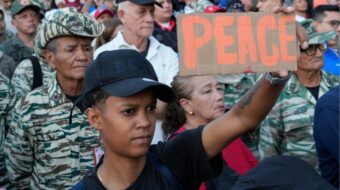
The U.S. warned again on Friday and that it had credible intelligence saying a Russian invasion of Ukraine could come in just days, likely on Feb. 20. A visibly angry Ukrainian President Volodymyr Zelensky responded in English at a press conference in Kiev, declaring that he had information that was different and that, as the country right next to Russia, his information that an invasion was not imminent was more valid. “These claims about an invasion coming are only causing panic and they do not help us,” he declared.
The continued release by the U.S. of “intelligence” reports about alleged Russian false flag operations and claims, day after day and month after month, of “imminent” invasion have taken on the character of a propaganda campaign against Russia rather than a serious effort to defuse tensions and avert war. None of the announcements about imminent invasion, including the latest ones this weekend, have been accompanied by any kind of proof.
Even Nina Khrushcheva—an international affairs professor at the New School, great granddaughter of Soviet Premier Nikita Khrushchev, and a long-time opponent of both the Soviet Union and Putin—said this weekend on MSNBC that she did not believe an invasion was coming. “I wonder how Biden is going to explain all his predictions of one,” she said, “when it turns out they don’t happen.”

The New York Times, all but vouching for the invasion claims, however, brings back memories of how that publication did the same years ago with false intelligence reports alleging weapons of mass destruction in Iraq, claims that helped start a deadly and long war.
While the U.S. continues spreading panic about a Russian invasion, a steady flow of sophisticated and offensive military weaponry, much of it from the U.S., continues to pour, planeload after planeload, into Ukraine.
On Friday, 3,000 U.S. troops entered Poland, and on the same day the U.S. admitted to the presence of U.S. National Guard troops in Ukraine itself. The Defense Department said 160 of them were pulling out of Ukraine, as if armed U.S. military forces were just like tourists who are leaving. No explanation was given about what they were doing there to begin with, and no one in the media asked for an explanation. Nor was any mention made of how many were remaining there.
The U.S. also admitted that Green Berets were now in Ukraine and that they were going to remain there. All this comes after months of claims that U.S. troops will not be involved on the ground in Ukraine.
The U.S. also condemned maneuvers involving Russian troops in Belarus near the border of Ukraine this weekend, as if they were something new. Those maneuvers have been an annual war games practice event for years before the current crisis. The U.S. government and the media both also fail to mention that for years now, long before Russia moved troops into its border region with Ukraine, U.S. troops have been maneuvering all around Ukraine and Russia, including in the Baltic states.
In Latvia, which along with Estonia and Lithuania was part of the old Soviet Union, American tanks flying American flags rumble through the streets of towns and cities every weekend, often within yards of the Russian border.
The media reported that President Joe Biden spoke again with Russia’s President Vladimir Putin to give diplomacy another chance this weekend.
During that meeting, as has been the case for months, there was a continued refusal by the U.S. to address even one of the key security issues Russia has been raising, including and especially a demand that the 2014 Minsk Protocols to which Ukraine agreed be implemented. Those agreements guarantee autonomy for the Russian-speaking separatist regions in the east of Ukraine and guarantee that NATO will not move into Ukraine. As it is, U.S. nuclear missiles in Germany are only 15 minutes from reaching Moscow. If Ukraine was in NATO, the danger to world peace would make the current crisis look like a minor one.
Placement of nuclear missiles by NATO in Ukraine, as has been done in Germany, would be one thing. But scenarios short of that would also be incredibly dangerous. Ukraine moving to retake Crimea, for example, would almost surely trigger a wider war.
Unlike the U.S., other countries in Europe are trying to make serious efforts at peace. French President Emmanuel Macron repeated this weekend that some progress was made in his talks with Putin. Macron said that one approach might be a neutral Ukraine, staying out of NATO, an approach followed by Finland during the Cold War.
He also said there was no security for Europe without security for Russia and that NATO alone cannot meet the security needs of Europe in our time. Putin has said there were “some seeds of reason” in the approach put forward by Macron. In any case, Macron and the German Chancellor, Olaf Scholz, have avoided the war mongering and threats coming from the U.S. In any case, what those other European leaders are doing is better than ignoring entirely the need to address at least some of the legitimate security needs of the Russians.
It should be no surprise that the approach of the U.S. State Department and the Biden administration is interpreted by the Russians as an attempt to deflect attention from a concerted effort by the West to carry out a military absorption of Ukraine into its sphere of influence, something that would be, on top of all the other NATO maneuvers eastward, an unacceptable threat to Russia.

If the West sees the buildup of Russian troops on Russia’s own territory along the Ukrainian border as a threat to its security it is difficult to understand how it cannot see its provocative anti-Russia campaign accompanied by the pumping of weapons into Ukraine as a threat to Russia. Pulling back from this dangerous standoff simply cannot be something that Russia alone is expected to do.
Meanwhile, the fascists operating all over Ukraine are not at all helping the situation. The New York Times and MSNBC reported that there was a “unity” rally attended by several thousand in Kiev on Saturday. They did not explain that the rally, as reported in People’s World, was the one announced two days earlier by a coalition of fascist organizations including the Azov Batallion, the Committee Against Capitulation, the Right Sector, and others. The ralliers, waving the banners of their fascist organizations, called for “no compromise” with Russia. The Western media, not surprisingly, avoided publicizing it.










